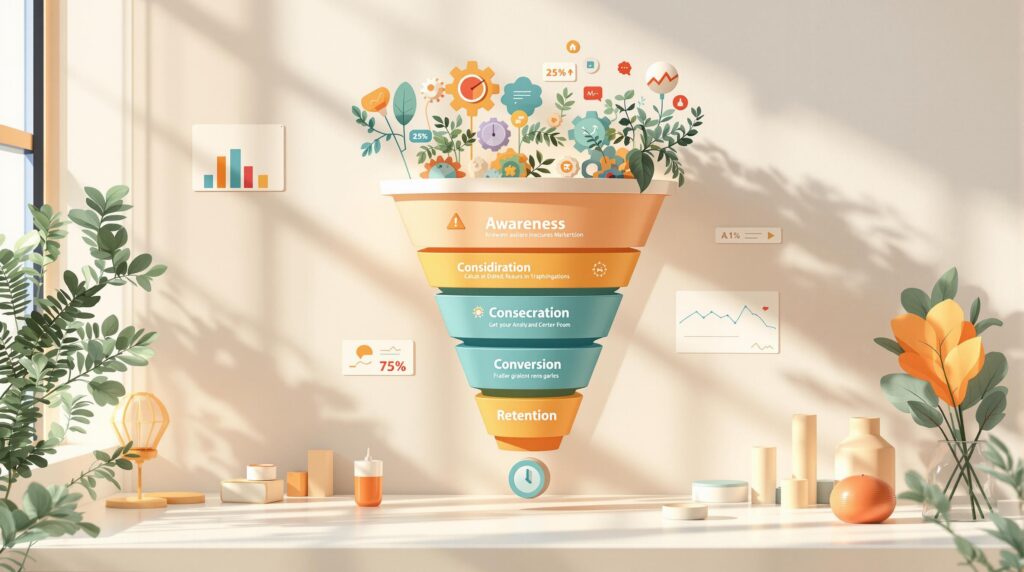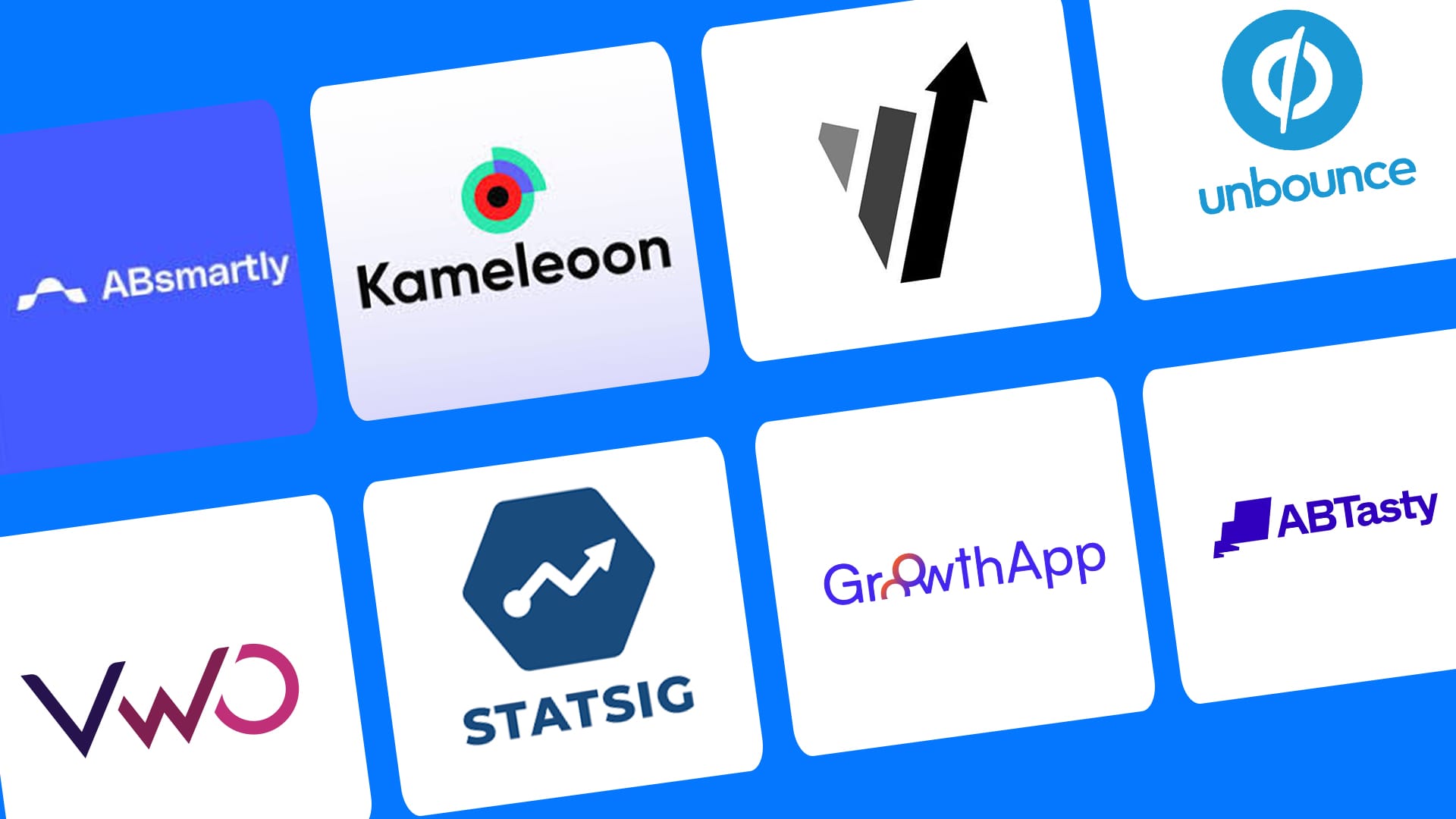Want to boost sales and retain customers? Funnel optimization is the answer. Here’s how it works:
- What is it? Funnel optimization aligns every step of the customer journey – awareness, consideration, conversion, and retention – to improve sales and ROI.
- Why does it matter? Customers interact with brands multiple times before buying. Connecting touchpoints ensures a seamless, consistent experience that builds trust and drives conversions.
- How to do it? Use data and AI to track user behavior, personalize content, automate tasks, and refine each stage of your funnel.
Key Takeaways:
- Track behavior: Tools like heat maps and cross-channel monitoring reveal where users drop off.
- Leverage AI: Automate tasks, segment audiences, and deliver personalized recommendations.
- Align channels: Ensure email, social media, websites, and mobile platforms work together.
- Test continuously: Experiment with landing pages, forms, and emails to maximize results.
By focusing on data-driven decisions, automation, and consistent messaging, businesses can create efficient funnels that convert more customers and build lasting relationships.
The Marketing Funnel | Using AI to improve your conversion rate
Customer Touchpoint Analysis
Take a closer look at how customers interact with your brand throughout their journey. This can help identify ways to improve their experience and increase engagement.
Customer Journey Steps
Customer interactions are divided into three main phases, each with specific touchpoints that influence purchasing decisions. Here’s a breakdown of these phases and their key actions:
| Journey Phase | Key Touchpoints | Impact Areas |
|---|---|---|
| Pre-Purchase | Social media engagement, online ads, search queries, content marketing | Building awareness, sparking interest |
| During Purchase | Website navigation, checkout process, sales support, promotional offers | Driving conversions, completing purchases |
| Post-Purchase | Product delivery, customer support, loyalty programs, feedback surveys | Ensuring satisfaction, encouraging loyalty |
By understanding these stages, businesses can adopt advanced tracking methods to uncover obstacles in the customer journey. Research highlights that seamless transitions between channels are critical for building brand loyalty.
Behavior Tracking Methods
Modern tools make it easier than ever to track customer behavior across various touchpoints:
-
Website Interaction Analysis
Use tools like heat maps, scroll depth tracking, and time-on-page metrics to understand how users navigate your site and where they drop off. -
Cross-Channel Monitoring
Many marketing teams rely on integrated dashboards to track performance across platforms and gather strategic insights. -
Customer Feedback Integration
Combine data from surveys, customer support tickets, social media comments, and interviews to gain a complete picture of customer sentiment and needs.
AI in Funnel Management
AI is reshaping funnel management by analyzing customer behavior and automating processes to create more tailored customer experiences.
Personal Experience Design
AI-driven personalization plays a major role in crafting engaging customer journeys. By using real-time data, AI delivers targeted content and recommendations that resonate with individual users. For instance, in March 2023, Spotify used Mailchimp‘s new Email Verification API to clean up a subscriber database of 45 million users. This real-time verification process cut email bounce rates from 12.3% to 2.1% in just 60 days, improved deliverability by 34%, and brought in an extra $2.3 million in revenue.
| AI Personalization Capability | Business Impact |
|---|---|
| Real-time content adaptation | Shows relevant content based on user behavior, boosting engagement |
| Dynamic email customization | Enhances open and click-through rates |
| Behavioral segmentation | Enables highly targeted campaigns for specific audiences |
| Smart product recommendations | Increases conversions with personalized suggestions |
This level of customization highlights how AI can also take over routine tasks to free up time for strategic work.
Task Automation
Beyond personalization, AI simplifies funnel management by automating repetitive tasks and offering predictive insights. This allows marketing teams to focus on strategy while maintaining consistent execution across all channels. A great example is Chooch.ai‘s partnership with Growth Hackers in June 2019. They implemented a sales funnel automation strategy using targeted LinkedIn posts and ads, which resulted in a 23% increase in qualified leads and helped secure $20 million in Series A funding.
Research shows that by 2024, 75% of marketers will rely on AI to enhance customer engagement and drive revenue. Additionally, top-performing marketing teams are twice as likely to incorporate AI into their campaigns compared to others.
AI automation shines in several key areas:
- Lead Scoring: Identifies high-potential leads using historical data
- Content Distribution: Automates personalized content delivery at optimal times
- Customer Support: Provides 24/7 assistance with AI chatbots
- Performance Analytics: Tracks and adjusts funnel metrics in real time
The global AI in marketing market is projected to hit $40.8 billion by the end of 2023, marking a 29.7% growth rate from 2019 to 2025. These numbers highlight AI’s growing importance in funnel management strategies today.
sbb-itb-22854bb
Touchpoint Connection Methods
Multi-Channel Alignment
Creating a smooth customer experience means ensuring all your marketing channels work together. The trick? Keep your messaging consistent while tailoring content to fit the format and style of each platform. This approach helps you connect with prospects effectively, no matter where they are in their journey.
Here’s a quick look at how to align different channels:
| Channel Type | Alignment Strategy | Key Considerations |
|---|---|---|
| Email Marketing | Personalized messaging flow | Segmentation, timing, verification |
| Social Media | Platform-specific content | Engagement patterns, format tweaks |
| Website | Unified brand experience | Smooth navigation, consistent content |
| Mobile | Responsive optimization | Load speed, user-friendly design |
Once your channels are working together, the next step is to fine-tune each touchpoint to maximize its impact.
Improvement Techniques
After aligning your channels, focus on refining each touchpoint using testing and data analysis. This ensures your content speaks to prospects at every stage of the funnel.
Here are some effective strategies:
- Data-Driven Refinement: Monitor key metrics like website traffic, conversion rates, and lead quality to find areas for improvement.
- Channel Prioritization: Invest in platforms that bring the best results for your business goals.
- Content Alignment: Keep your messaging consistent, but adjust how it’s delivered based on the channel.
Performance Tracking
Success Metrics
Since 96% of visitors don’t make a purchase right away, keeping an eye on key metrics is essential.
Here’s a breakdown of metrics to track at different stages of the funnel:
| Funnel Stage | Key Metrics | Target Goals |
|---|---|---|
| Awareness | Traffic sources, bounce rate, time on site | Boost engagement |
| Interest | Content interaction, email sign-ups | Generate leads |
| Consideration | Lead quality score, nurture email open rates | Find qualified prospects |
| Intent | Demo requests, pricing page visits | Create sales opportunities |
| Conversion | Conversion rate, acquisition cost, customer value | Drive revenue growth |
For example, Chooch.ai saw a 23% increase in qualified leads and tripled their conversion rates by using automated lead nurturing strategies.
"Real-time data analytics are vital for optimizing marketing efforts…tracking user engagement and campaign performance enables businesses to make informed adjustments. This approach leads to improved ROI and a better understanding of customer needs, allowing for more targeted marketing initiatives." – Growth Hackers
This kind of data-driven approach allows for continuous testing, helping you refine your funnel and improve results over time.
Continuous Testing
To keep improving, it’s important to test different elements of your funnel consistently. A structured testing process is key, but you also need to stay flexible to respond to changing customer behaviors.
Here’s how to run effective tests:
- Run tests for at least 7 days to account for weekly trends.
- Focus on Metrics: Prioritize key indicators that align with your goals.
- Evaluate Impact: Use the RRF Framework (Reach x Relevance x Frequency) to measure the potential of your test ideas.
Take Duolingo as an example – they increased their Day 1 retention rate from 13% to 55% (a 4.2x improvement) by running hundreds of structured experiments. This shows how regular testing can lead to major improvements.
To get the most from your testing efforts, focus on these areas:
| Testing Area | Focus Points | Measurement Criteria |
|---|---|---|
| Landing Pages | Headlines, copy, design | Conversion rate, bounce rate |
| Sign-up Forms | Field placement, form length | Completion rate, abandonment |
| Trust Elements | Guarantees, security badges | User confidence metrics |
| Email Campaigns | Subject lines, CTAs | Open rates, click-through rates |
Conclusion
Optimizing your marketing funnel with well-aligned touchpoints is a key driver of business growth today. Automated lead nurturing and CRM systems have been shown to boost conversion rates by up to three times.
Here are some essential strategies for improving funnel performance:
| Strategy Component | Impact | Implementation Focus |
|---|---|---|
| Marketing Automation | Simplifies processes and scales easily | Lead nurturing, CRM integration |
| Real-time Analytics | Enables smarter decisions | Tracking user engagement |
| Multi-channel Alignment | Delivers a consistent brand image | Managing integrated campaigns |
| Content Strategy | Builds authority and trust | Crafting targeted content |
These components work together to create a strong foundation for effective funnel management. Establishing multiple touchpoints allows you to track customer interactions, fine-tune campaigns, maintain consistent messaging, and adapt to changing market conditions.
AI and behavioral insights play a crucial role here, as they help refine strategies at every stage of the funnel. Studies confirm that customers often need several interactions with a brand before making a purchase decision.
"By creating multiple touchpoints, you can better track the interactions someone has with your brand. This data can then create more targeted and effective marketing campaigns." – Growth Hackers
To succeed, funnel optimization should be an ongoing process. By focusing on automation, customer journey touchpoints, and data-driven decisions, businesses can build scalable, efficient marketing systems that deliver consistent results over time. This approach ties together the strategies discussed throughout this guide.



